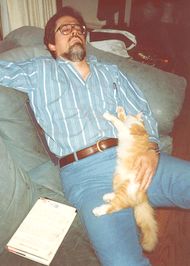Anna Anderson
WAS
the Grand Duchess Anastasia of Russia
Michael Ray Laurence © 1999
 I am most interested in contact with persons who are pursuing the matter from the following standpoint, in which I now have a high degree of confidence. Please email me: Michael Ray Laurence
I am most interested in contact with persons who are pursuing the matter from the following standpoint, in which I now have a high degree of confidence. Please email me: Michael Ray Laurence
I contend:
- The “Bones” are not those of the Imperial family – it has taken the security formations of the now-disguised Soviet state this long to discover and recover, amongst the millions of victims of the state, the bones of a family of five, with the approximately correct gender, age and physical characteristics, survived by a descendant to provide DNA-matching blood. To have recovered such a family of seven had no reasonable prospect of success, hence the “Yurovsky Report” – “explaining,” in implausible terms, why only five family skeletons were recovered from the grave.
- The “Yurovsky Report” is a contrivance – which, had it been authentic, would long ago have been recovered from the files of the security formations and used to direct investigators to the (from a diplomatic standpoint) supremely important gravesite. The allegation that such a vital and valuable document was casually handed to an amateur investigator from “secret” files, and the appearance of indifference to the matter on the part of the “Russian” authorities themselves, condemn this episode as the security force “operation” which its native critics believe it to have been.
- The Maucher blood testing demonstrates the fraud involved in the provenance and possession of samples which issue from the highly interested parties amongst the British and the Russians. The fact that Ivanov worked alongside Gill further undermines confidence in the integrity of samples that were offered for comparison with the bones, which are here believed not to have been those of the Imperial family. Thus, all authentic examples of Imperial tissue honestly tested against the bones and blood can be expected to give negative results hereafter.
- The forensic evidence and testimony as to the identity of Anna Anderson, prior to the DNA “testing,” were conclusive, beyond all reasonable doubt, in favor of her claim to be the lost Grand Duchess. The mismatch of her tissue with the bones and blood under discussion must then discredit the latter as simply the latest exhibits in a long line of Soviet disinformation and deception operations, which continue to the present day. The knowledgeable works of ex-KGB Major Anatoliy Golitsyn are instructive in regard to this larger context and give credibility to the framework established for this account.
Unfortunately, the only way DNA testing could now be given credibility, would be to have one of the Schweitzers personally draw some royal blood and transport it secretly to an obscure laboratory (if some trace of Anastasia’s tissue is still available). Of course, the opposition would then make the reciprocal claim of fraud and conspiracy, granting the Schweitzers no satisfaction in the public arena. I am pained and grieve for them that the vindication that should be theirs now seems so difficult of achievement. I believe, however, that there is some consolation in understanding the means and purposes, by and for which, this satisfaction was denied to them and to the many of us as well.
Related articles:
Stanford study questions identity of alleged Romanov bones
2-Mar-2004 by Esther Landhuis, Stanford News Service.
http://www.eurekalert.org/pub_releases/2004-03/su-ssq030204.php
One of the most riveting detective stories of the last century supposedly ended in 1998, when the Russian government declared that bones excavated from a Siberian mass grave seven years earlier indeed belonged to the Romanovs, Russia’s last royal family, who were executed by the Bolsheviks in 1918.
A new study, however, is reopening the book.
A team led by Alec Knight, a senior scientist in the Stanford lab of anthropological sciences pssistant Professor Joanna Mountain, argues that previous DNA analyses of the purported Romanov remains – nine skeletons unearthed near Ekaterinburg in central Russia – are invalid. Knight and his colleagues base their claim on molecular and forensic inconsistencies they see in the original genetic tests, as well as their independent DNA analysis of the preserved finger of the late Grand Duchess Elisabeth – sister of Tsarina Alexandra, one of the 1918 victims – which failed to match the tsarina’s own DNA. The Stanford team’s findings are reported in the January/February issue of the Annals of Human Biology.
Flawed experiments?
The original DNA analysis was arranged by the Russian government’s Commission on the Identification of the Remains. As reported in Nature Genetics in 1994, Peter Gill of Britain’s Forensic Science Service and Pavel Ivanov, a Russian geneticist from the Engelhardt Institute in Moscow, conducted a battery of experiments supporting the hypothesis that the Ekaterinburg bones belonged to the Romanovs. The team performed DNA-based sex testing and analyzed short sequences of DNA from the nucleus of bone cells to establish that the remains of the alleged tsar, tsarina and three daughters belonged to the same family.
To solidify these conclusions, Gill and Pavel also examined DNA from mitochondria, the energy-producing organelles within cells. Compared to DNA found inside the nucleus, mitochondrial DNA preserves well in bones and acquires mutations very slowly – making it a prized specimen for multigenerational forensic analysis. But there is a catch: Mitochondrial DNA is passed only along the maternal line. For the 1994 study, researchers determined the sequence of mitochondrial DNA fragments from the presumed Romanov skeletons and found that they matched DNA sequences obtained from blood samples of Britain’s Prince Philip (Tsarina Alexandra’s grandnephew) and two living relatives of the tsar’s maternal grandmother.
Knight argues these results are too good to be true. In particular, he doubts the researchers could have obtained such long stretches of DNA sequence (a string of 1,223 bases, DNA’s chemical building blocks) from old bones. Citing standards for ancient DNA analysis that were established several years after the 1994 publication, Knight contends that DNA from skeletal remains that spent over 70 years in a shallow, earthen grave would have degraded so severely that sequences longer than 250 bases would have been nearly impossible to recover in lab experiments.
“Based on what we know now, those bones were contaminated,” Knight said. He considers the successful amplification of a 1,223-base sequence from all nine skeletons in the original study as “certain evidence” that the bone samples were tarnished with fresh, less-degraded DNA – perhaps from an individual who handled the samples.
As reported recently in Science, Gill maintains that his team’s DNA analysis “set the standard.” He says that Knight’s paper mischaracterizes his work and “comes across as vindictive and political.”
Blood-soaked evidence
Peter de Knijff, head of the Forensic Laboratory for DNA Research at Leiden University Medical Center in the Netherlands, agrees with Knight’s assessment that the Gill-Ivanov study was “unrealistically solid.”
De Knijff’s qualms about the original study also stem from Ivanov’s unwillingness to disclose results from his analysis of a blood-soaked handkerchief that Tsar Nicholas II used to treat a head wound suffered after he was struck by a would-be assassin in Japan in 1891. The handkerchief is a “potentially pristine source of DNA of the last tsar,” according to de Knijff, noting that Ivanov refused to disclose experimental details and claimed that the handkerchief DNA was degraded and hence analysis was unfeasible – an assertion that other scientists dispute.
These sorts of irregularities provided the original impetus for Knight’s entry into the forensic debate. About three years ago, Daryl Litwin, an author of the Knight et al. paper who was studying law in Sacramento, proposed to Knight the idea for a re-analysis of the Gill-Ivanov data after reading Robert Massie’s book The Romanovs: The Final Chapter. “I just kept finding contradiction and discrepancy from point to point,” Litwin said. “I was left kind of befuddled.” Before approaching Knight, Litwin discussed his ideas with a Russian history expert at the Hoover Institution at Stanford, who agreed that the Romanov verdict was worth re-examining.
Months later, Knight went to New York to procure a small wooden case containing a finger of Grand Duchess Elisabeth. Since the 1982 opening of Elisabeth’s coffin in Jerusalem, the finger had been preserved in a reliquary at the New York home of Bishop Anthony Grabbe, president of the now-disbanded Orthodox Palestine Society.
Though Knight’s trip was funded by the Russian Expert Commission Abroad – a group of about 20 scholars in the West and Russia who challenge the assertion that the bones are royal – Knight maintains that his experiments were unbiased. “[The Commission Abroad] didn’t do the science,” he said. “They just bought me the plane ticket and got me the sample. They had no control over the work.”
Continuing controversy
Nevertheless, some scientists – several of whom participated in the original DNA analyses – are unconvinced by Knight’s conclusions. Mark Stoneking, a molecular anthropologist at the Max Planck Institute for Evolutionary Anthropology in Leipzig, Germany, concludes that “it is certainly plausible that DNA preservation was sufficient to permit amplification of large fragments.”
Tom Parsons of the Armed Forces DNA Identification Laboratory in Rockville, Md., and Victor Weedn, a forensic scientist who established the U.S. military’s DNA identification program, agree that the discovery of the Ekaterinburg remains in an area of permafrost explains how larger DNA fragments were stable enough to be recovered in the original analyses.
Knight agrees that frozen DNA is more stable but points out that Ekaterinburg – which is at the same latitude as Moscow and just north of Kazakhstan – can reach 100 degrees Fahrenheit in July and August.
Meanwhile, as scientists squabble over finer details of the forensic analysis, historians seem content with a more holistic view of the Romanov drama.
“There may be some ambiguity about which physical remains belong to whom, but this uncertainty doesn’t really change our fundamental understanding of the Russian Revolution and the nature of Bolshevism,” said Robert Crews, an assistant professor of history at Stanford.
Donald Ostrowski, a Russian historian at Harvard University, said he had doubts about the Ivanov and Gill analysis of the bones, so he “just decided to eliminate it from [his] consideration of the historical evidence.” Though he has concluded from probabilistic analysis of existing evidence that the bones belong to the Romanovs, Ostrowski remains open to hearing new evidence or re-analysis of old data. “The case is by no means closed,” he said.
DNA Report Revives Czar Mystery
By Randy Dotinga Wired.com 3-4-4
http://www.wired.com/news/print/0,1294,62529,00.html
Resurrecting a debate over one of the 20th century’s most enduring mysteries, a team of scientists is casting doubt on DNA tests that confirmed the deaths of Czar Nicholas II, the last ruler of imperial Russia, and most of his family.
In a newly released report, the scientists declare that the testing of remains found in the Ural Mountains was shoddy and flawed. They add that their own tests on the preserved finger of the sister of the czar’s wife raise even more questions about the original findings.
“There was a rush to judgment,” said report co-author Alec Knight, senior research scientist at Stanford University. “It’s up to the scientific community to evaluate whether it’s feasible to get results like that.”
The findings are infuriating the scientists who reported and confirmed the original DNA tests in the mid-1990s. “Could we all be duped? I just believe that is inconceivable,” said Dr. Victor Weedn, principal research scientist at Carnegie Mellon University, who confirmed some of the original DNA findings. “The group of people who have been working on these things are honest and trustworthy.”
The glamorous Romanovs, the ruling dynasty of Russia, lost power during the Bolshevik Revolution in 1917. Czar Nicholas II, Empress Alexandra and their children – Alexis, Olga, Tatiana, Maria and Anastasia, all of whom were in their teens or early 20s – were packed off to exile in the Ural Mountains.
Late one night, according to witnesses, their imprisonment ended when the entire family was executed by firing squad, along with their doctor, three servants and Anastasia’s pet King Charles spaniel.
The Romanovs have haunted the popular imagination ever since. Books, documentaries and movies have explored everything from the love affair between Nicholas and Alexandra to Alexis’ life-threatening hemophilia, inherited from his grandmother, Great Britain’s Queen Victoria.
Most famously, women have claimed to be the long-lost Anastasia, spawning an Ingrid Bergman film and endless speculation about a courageous surviving princess.
In 1991, as the Soviet Union fell apart, researchers exhumed nine bodies from a bog near Ekaterinburg. Tests on mitochondrial DNA – handed down by mothers – confirmed genetic links between the bodies of four females and Great Britain’s Prince Philip, who is related to Empress Alexandra.
Mitochondrial DNA tests also linked the body of an adult male to the exhumed body of Czar Nicholas’ brother; both had a rare mutation that left them with two forms of mitochondrial DNA. Finally, nuclear DNA tests connected two adults and the four young women to each other.
In all, the researchers concluded that the bodies in the grave were those of the czar, his wife, three of their four daughters, and four other people – presumably the doctor and the three servants. The son, Alexis, and one daughter – Anastasia? – are missing. However, DNA tests suggested that the most famous Anastasia wannabe, an American woman named Anna Anderson, was not related to Empress Alexandra.
The new report, in the Jan. 28 online edition of the Annals of Human Biology, questions the DNA findings. The authors, including geneticists from Stanford University and the Russian Academy of Sciences, allege that “major violations of standard forensic practices” took place, and they suspect that “fresh” DNA – perhaps from researchers – contaminated the samples.
They also allege that the DNA testing produced results that were too specific for such old, decayed remains. “If you obtain results like that, they’re evidence of contamination,” Knight said.
Through a spokesman, the researcher behind the original findings declined to comment because he is working on a formal response. But the researcher, Peter Gill of Great Britain’s Forensic Science Service, did appear in the journal Science, saying Knight’s work is “vindictive and political.”
Weedn, the principal research scientist at Carnegie Mellon University, defended the original findings, pointing out that the remains were found in an area of permafrost that could have preserved them. After all, he said, DNA results are often preserved through freezing. Knight counters that summer temperatures can go quite high in the region, and he doubts permafrost is there at all. “People are grasping for straws because they know it’s impossible to get those results from these badly decomposed bones,” he said.
Another researcher who worked on the original Romanov projects expressed amazement at the idea that the DNA from the remains could have been contaminated yet still reveal links to Prince Philip and the czar’s brother.
“That is not going to happen by accident. What has to be implied here is some kind of bizarre conspiracy theory,” said Tom Parsons, chief scientist of the Armed Forces DNA Identification Lab, whose office confirmed the DNA tests that linked Czar Nicholas to his brother. If the contamination came from “some random schmo,” it wouldn’t magically provide a link to the czar, he added.
In response, Knight insisted that he isn’t accusing the researchers of working together to twist the truth. “I never dreamed that all those people got together and committed conspiracy,” Knight said, although he hinted that others may have tinkered with the remains. “All sorts of people have vested interests in this thing.”
In search of support for their theories, the authors of the new study turned to a preserved finger that apparently belonged to Grand Duchess Elisabeth, Empress Alexandra’s sister, who was killed by the Bolsheviks in 1918. A Russian Orthodox bishop kept the finger, considered a relic, after Elisabeth’s coffin was opened in Jerusalem in 1981.
DNA tests on the finger, which consists of bone and dried flesh, failed to conclusively link it to the empress’s genetic profile, the study authors said, creating “yet another discrepancy.” However, the researchers found the finger was contaminated with the DNA of at least two other people.
It’s unclear if the new report will inspire any more DNA testing.
Copyright 2004, Lycos, Inc.
Email me to discuss: Michael Ray Laurence


